Navy Pilot Remembers
*IN MEMORIAM*
Leonard Delbert “Del” Byler passed away August 18, 2018 at the age of 99. Read his obituary at SanBenito.com.
Use controls above or click here to open this Hometown Heroes podcast in a new window
98-year-old Del Byler of Hollister, CA appears on episode #490 of Hometown Heroes, airing September 22-24, 2017. A native of Kalvesta, KS, Byler was a Navy fighter pilot during World War II and the Korean War.
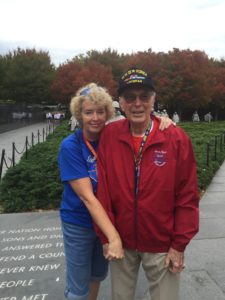
Del Byler with daughter Debbie at the Korean War Veterans Memorial with Honor Flight Bay Area. For more photos, visit the Hometown Heroes Facebook page.
You’ll hear Byler recall his childhood in rural western Kansas, near an unincorporated hamlet called Kalvesta, which now boasts 3,500 people, but in the 1920s held a population of 12. “We had two gas stations, a general store, and a couple of residences,” Del recalls. “That’s all.” As a young boy, Del would ride a horse seven miles each way to a one-room schoolhouse. For high school, his family sent him to stay with an aunt and uncle in Topeka, where he transitioned from a student body of 7 to enrollment of roughly 3,000. He was a pre-med major at the University of Kansas, but quit school after vicious dust storms ravaged the state, choosing to go to work in Chicago because he couldn’t bear spending the family’s money on college when finances were so tight.
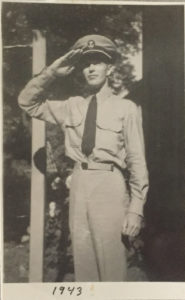
Del was working for Permoflux, a speaker manufacturer, and the owner of the company had an airplane. He paid for Del’s flying lessons, and soon Byler had his private pilot’s license. Stunned by the Japanese attack on Pearl Harbor, Byler and a Permoflux co-worker went the next morning, December 8, 1941, to enlist in the Army Air Corps. He learned for the first time that he was color blind, but was sworn in despite failing that eye test. Awaiting a military assignment that never came, he finally wrote a letter, receiving a personal response from the head of the Army Air Corps, thanking him for his patriotism but rejecting his enlistment and instructing him instead to report to his local draft board.
“That was disaster,” Byler explains. “I didn’t want to report to the draft board, I wanted to fly.”
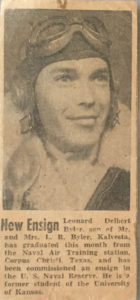
Determined to find his way into the cockpit one way or another, he ate as many carrots as he could, hoping that his eyesight would improve. He also studied the eye chart, devising a way to cheat the color charts. Enlisting this time in the Navy, he passed the vision tests, only to be told he was five pounds underweight. He wasn’t going to let five pounds get in the way of his dream, so Byler ate a big breakfast at a Chicago restaurant, then consumed all the bananas he could get his hands on.
“I took a big drink of water before I got on the scale, and I gained five and a half pounds in an hour,” you’ll hear him remember.
So began a military career that would span two decades. After training in Missouri and Texas, where he earned his naval aviator wings, he was shipped to Melbourne, FL and preparing to head overseas in a squadron of F6F Hellcats. The Navy asked for volunteers to enter night fighter training, but when not enough pilots volunteered, the top ten percent of the class was siphoned off into the new program. That included Del, who was disappointed he wouldn’t be heading overseas just yet. The night fighter versions of the F6F were equipped with the latest Navy technology, including a radio altimeter that was more accurate than its predecessors and allowed the pilots to fly at very low altitude. “I flew under telephone wires one time,” Byler quips. While he was finishing up his night fighter training in Martha’s Vineyard, MA, he took a five-day leave to marry a young lady he had met at a Chicago dinner party years earlier. Listen to Hometown Heroes to find out why Del ended up 12 minutes late to his own wedding on June 9, 1945.
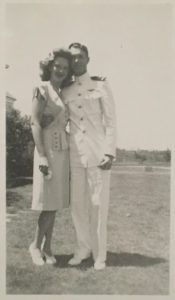
Del and Jeannie Byler would go on to have six children. Good thing she forgave him for being late to their wedding!
Soon he would be kissing his new bride, Jeannie, goodbye, and heading to the Pacific on the USS Enterprise (CV-6). The best man in their wedding, Dick LaBar, was assigned to a different carrier. You’ll hear Byler explain the freak accident that soon claimed LaBar’s life and served as a sobering reminder of the inherent hazards of taking off and landing on carriers. “It’s not the safest vocation in the world,” Del says. The “Big E,” meanwhile, with Byler aboard, was steaming toward for the planned invasion of Japan.
“That armada stretched from horizon to horizon,” you’ll hear him recall. “You could look in any direction and see nothing but warships.”
Soon the atomic bombs deployed against Hiroshima and Nagasaki hastened the Japanese surrender, and instead of flying dangerous missions over heavily defended territory, Del was taking off from the Enterprise’s deck for Navy Day festivities in New York. Listen to the interview to hear how he arrived a day early and surprised Jeannie at Grand Central Station, and why he calls it “one of the best events I ever had.” Thankful the war was over, Del also held some disappointment that he hadn’t been able to put all of his training to use in action against the enemy. After his discharge from the Navy, he had no plans to fly military aircraft again. But five years later, with two small children, because he “needed the money and loved to fly,” he joined the ready reserve. It was during his reserve duty that a seemingly routine flight in an F8F Bearcat over Chicago nearly proved deadly.
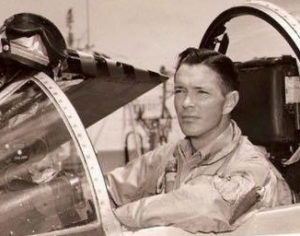
“All of a sudden a major oil line broke,” you’ll hear him recall of the moment that oil spurted out all over his windshield. “I knew enough to know this plane ain’t going to fly very long without oil.” He gained as much altitude as he could before the engine quit, let the tower know that he would be trying to make an emergency landing, and hoped he would make it to his base in Glenview, IL.
“It was either you make it or you die, one of the two,” Byler remembers. “I didn’t think about being nervous, but I’m sure I was.”
Bringing the disabled Bearcat in “high and hot,” the pilot used every bit of braking power he had but couldn’t slow it down to his satisfaction, so he executed a ground loop at the end of the runway. “Never scratched the paint on the plane,” you’ll hear him say. “But I burned up the brakes.”
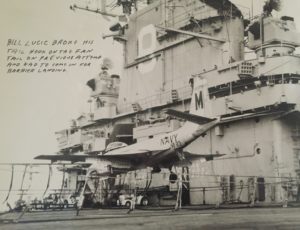
Del understood the hazards of landing twin-engine F2H-3 Banshee jets on the flat deck of the USS Essex, especially after witnessing this close call for his friend Bill Lucic.
Listen to Hometown Heroes for Del’s description of another close call that left him buzzing the tower at Moffett Field in California’s Bay Area. His F2H-3 Banshee had lost electric power and he had no other way of communication. After landing, he realized his anti-gravity suit had mistakenly been filled with aviation gas. What if there had been a spark in the cockpit? “I would’ve gone up in a big flame,” he says. Remaining aboard the USS Essex (CV-9) after the end of the Korean War, Byler ended up with a mission shrouded in secrecy and laden with potential danger. As the communist Viet Minh laid siege to the French held city of Dien Bien Phu, the Pentagon weighed American intervention beyond allowing the French to use U.S. equipment. It was 1954, more than a decade before the U.S. would become fully involved in the Vietnam War, but the battle for Dien Bien Phu claimed the first two American casualties in Vietnam. Civil Air Transport, a CIA-backed outfit that was supplying French forces through airdrops, had a C-119 shot down over Dien Bien Phu on May 6, 1954. Pilot James “Earthquake McGoon” McGovern and his co-pilot, Wallace Buford were both killed. Just a few weeks before that, Del Tyler and three other Banshee pilots from the Essex were flying over the city in their jets, fully armed as they escorted photo reconnaissance planes.
The pilots were carrying sidearms, had been briefed on escape and evasion tactics in the event they were shot down, and their Banshees had full ammunition loads fed into their 20mm cannon chambers.
“All we had to do was flip a switch and pull the trigger and we were in business,” he explains. “We felt 95% sure we were going to fight. We were on a wartime basis.”
He spent 13 years of his two-decade Navy career on active flying status, but his most recent cockpit adventure came in 2015 with Honor Flight Bay Area, joining other World War II veterans on a sentimental journey to Washington, D.C. to visit memorials. When the flight crew learned he was the only pilot among the veteran contingent, he was invited to sit up front and take in the view, but he wasn’t given the controls. “They wouldn’t let me land it,” he jokes.
Listen to Hometown Heroes for Del’s take on his Honor Flight experience. You’ll also hear from his daughter, Debbie, who served as his guardian during the trip. As he approaches his 99th birthday, Byler says there are two things he’s proud of. One is the family of six children that he and his late wife, Jeannie, raised. And the other?
“I flew jets off of a carrier at night, and not many guys would dare do that.”

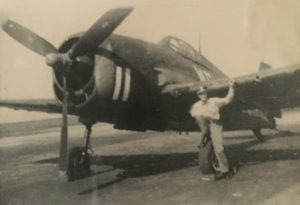
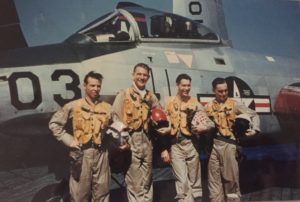
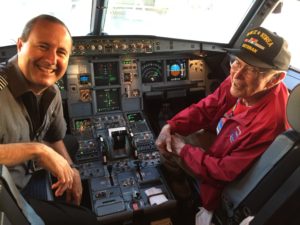

Greatest Generation is not just lip service, no truer words were ever spoken. Thanks for your service sir!
Thank You Del for giving so much Blessings CUHS1965
Thank you for your service and for being a wonderful man!
Thank you Del for sharing this information about a wonderful patriotic military career.
I’m reading this and wondering the whole time if he knew my Great Uncle. Charles “Sam” Muckenthaler also grew up in rural Kansas (Paxico/Newbury) and was a Naval aviator. He actually survived the attack at Kenoe, HI then flew in the European theater and back to the Pacific.
Del sounds like a heck of a guy.
So great to hear your voice, and your stories, again, Dad. Love you, proud of you…miss you! 💛